Besnik Fetahu
Wizard of Shopping: Target-Oriented E-commerce Dialogue Generation with Decision Tree Branching
Feb 03, 2025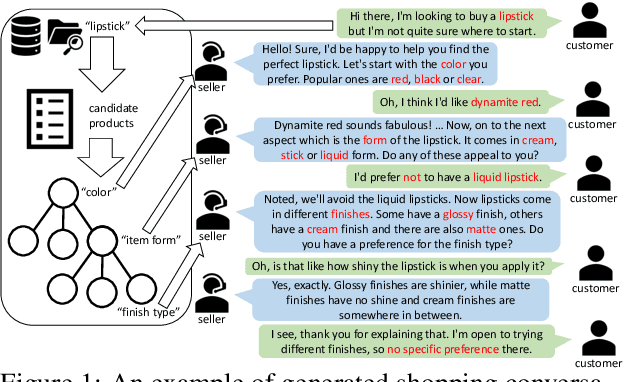

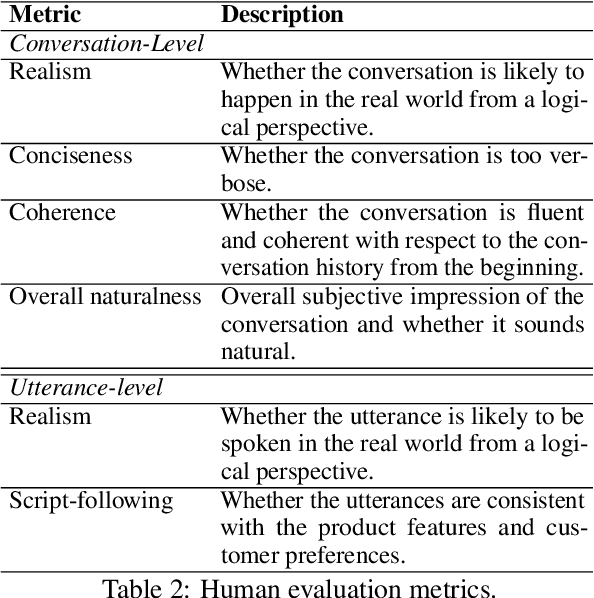

Abstract:The goal of conversational product search (CPS) is to develop an intelligent, chat-based shopping assistant that can directly interact with customers to understand shopping intents, ask clarification questions, and find relevant products. However, training such assistants is hindered mainly due to the lack of reliable and large-scale datasets. Prior human-annotated CPS datasets are extremely small in size and lack integration with real-world product search systems. We propose a novel approach, TRACER, which leverages large language models (LLMs) to generate realistic and natural conversations for different shopping domains. TRACER's novelty lies in grounding the generation to dialogue plans, which are product search trajectories predicted from a decision tree model, that guarantees relevant product discovery in the shortest number of search conditions. We also release the first target-oriented CPS dataset Wizard of Shopping (WoS), containing highly natural and coherent conversations (3.6k) from three shopping domains. Finally, we demonstrate the quality and effectiveness of WoS via human evaluations and downstream tasks.
Identifying High Consideration E-Commerce Search Queries
Oct 17, 2024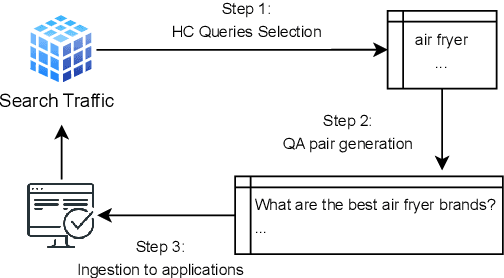
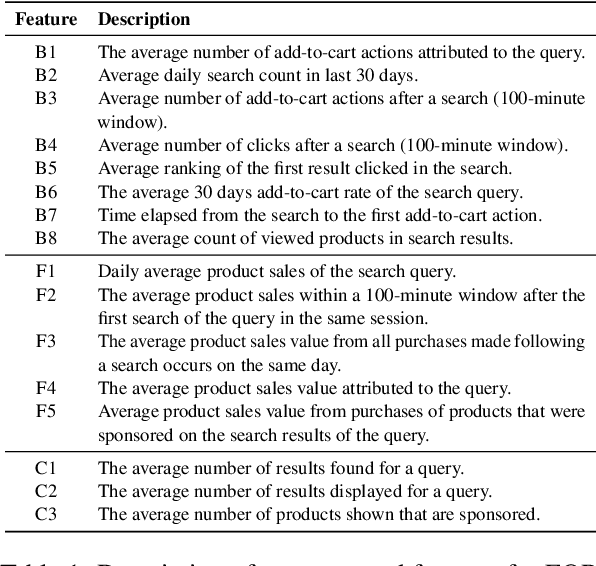
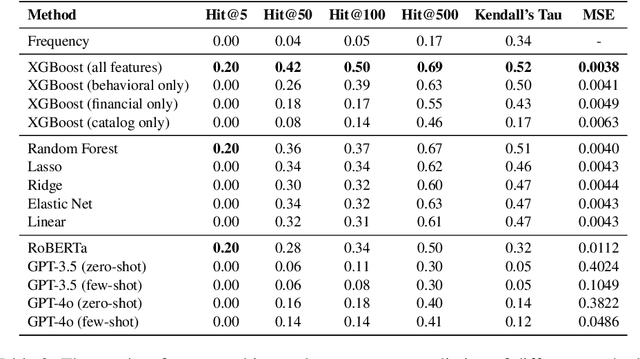

Abstract:In e-commerce, high consideration search missions typically require careful and elaborate decision making, and involve a substantial research investment from customers. We consider the task of identifying High Consideration (HC) queries. Identifying such queries enables e-commerce sites to better serve user needs using targeted experiences such as curated QA widgets that help users reach purchase decisions. We explore the task by proposing an Engagement-based Query Ranking (EQR) approach, focusing on query ranking to indicate potential engagement levels with query-related shopping knowledge content during product search. Unlike previous studies on predicting trends, EQR prioritizes query-level features related to customer behavior, finance, and catalog information rather than popularity signals. We introduce an accurate and scalable method for EQR and present experimental results demonstrating its effectiveness. Offline experiments show strong ranking performance. Human evaluation shows a precision of 96% for HC queries identified by our model. The model was commercially deployed, and shown to outperform human-selected queries in terms of downstream customer impact, as measured through engagement.
Generative Explore-Exploit: Training-free Optimization of Generative Recommender Systems using LLM Optimizers
Jun 07, 2024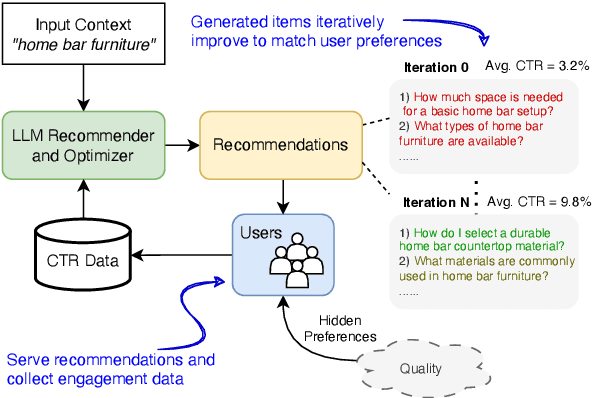



Abstract:Recommender systems are widely used to suggest engaging content, and Large Language Models (LLMs) have given rise to generative recommenders. Such systems can directly generate items, including for open-set tasks like question suggestion. While the world knowledge of LLMs enable good recommendations, improving the generated content through user feedback is challenging as continuously fine-tuning LLMs is prohibitively expensive. We present a training-free approach for optimizing generative recommenders by connecting user feedback loops to LLM-based optimizers. We propose a generative explore-exploit method that can not only exploit generated items with known high engagement, but also actively explore and discover hidden population preferences to improve recommendation quality. We evaluate our approach on question generation in two domains (e-commerce and general knowledge), and model user feedback with Click Through Rate (CTR). Experiments show our LLM-based explore-exploit approach can iteratively improve recommendations, and consistently increase CTR. Ablation analysis shows that generative exploration is key to learning user preferences, avoiding the pitfalls of greedy exploit-only approaches. A human evaluation strongly supports our quantitative findings.
Identifying Shopping Intent in Product QA for Proactive Recommendations
Apr 09, 2024


Abstract:Voice assistants have become ubiquitous in smart devices allowing users to instantly access information via voice questions. While extensive research has been conducted in question answering for voice search, little attention has been paid on how to enable proactive recommendations from a voice assistant to its users. This is a highly challenging problem that often leads to user friction, mainly due to recommendations provided to the users at the wrong time. We focus on the domain of e-commerce, namely in identifying Shopping Product Questions (SPQs), where the user asking a product-related question may have an underlying shopping need. Identifying a user's shopping need allows voice assistants to enhance shopping experience by determining when to provide recommendations, such as product or deal recommendations, or proactive shopping actions recommendation. Identifying SPQs is a challenging problem and cannot be done from question text alone, and thus requires to infer latent user behavior patterns inferred from user's past shopping history. We propose features that capture the user's latent shopping behavior from their purchase history, and combine them using a novel Mixture-of-Experts (MoE) model. Our evaluation shows that the proposed approach is able to identify SPQs with a high score of F1=0.91. Furthermore, based on an online evaluation with real voice assistant users, we identify SPQs in real-time and recommend shopping actions to users to add the queried product into their shopping list. We demonstrate that we are able to accurately identify SPQs, as indicated by the significantly higher rate of added products to users' shopping lists when being prompted after SPQs vs random PQs.
Instant Answering in E-Commerce Buyer-Seller Messaging using Message-to-Question Reformulation
Jan 30, 2024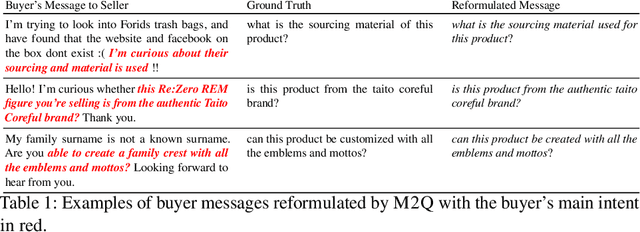

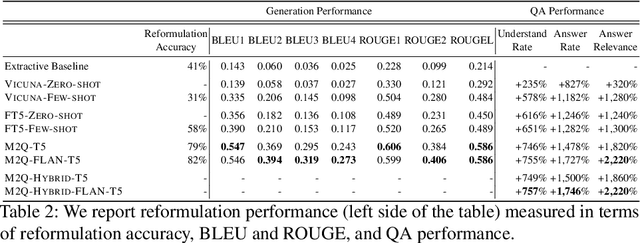
Abstract:E-commerce customers frequently seek detailed product information for purchase decisions, commonly contacting sellers directly with extended queries. This manual response requirement imposes additional costs and disrupts buyer's shopping experience with response time fluctuations ranging from hours to days. We seek to automate buyer inquiries to sellers in a leading e-commerce store using a domain-specific federated Question Answering (QA) system. The main challenge is adapting current QA systems, designed for single questions, to address detailed customer queries. We address this with a low-latency, sequence-to-sequence approach, MESSAGE-TO-QUESTION ( M2Q ). It reformulates buyer messages into succinct questions by identifying and extracting the most salient information from a message. Evaluation against baselines shows that M2Q yields relative increases of 757% in question understanding, and 1,746% in answering rate from the federated QA system. Live deployment shows that automatic answering saves sellers from manually responding to millions of messages per year, and also accelerates customer purchase decisions by eliminating the need for buyers to wait for a reply
Controllable Decontextualization of Yes/No Question and Answers into Factual Statements
Jan 18, 2024
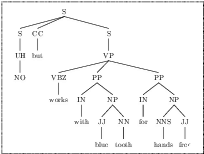


Abstract:Yes/No or polar questions represent one of the main linguistic question categories. They consist of a main interrogative clause, for which the answer is binary (assertion or negation). Polar questions and answers (PQA) represent a valuable knowledge resource present in many community and other curated QA sources, such as forums or e-commerce applications. Using answers to polar questions alone in other contexts is not trivial. Answers are contextualized, and presume that the interrogative question clause and any shared knowledge between the asker and answerer are provided. We address the problem of controllable rewriting of answers to polar questions into decontextualized and succinct factual statements. We propose a Transformer sequence to sequence model that utilizes soft-constraints to ensure controllable rewriting, such that the output statement is semantically equivalent to its PQA input. Evaluation on three separate PQA datasets as measured through automated and human evaluation metrics show that our proposed approach achieves the best performance when compared to existing baselines.
Follow-on Question Suggestion via Voice Hints for Voice Assistants
Oct 25, 2023Abstract:The adoption of voice assistants like Alexa or Siri has grown rapidly, allowing users to instantly access information via voice search. Query suggestion is a standard feature of screen-based search experiences, allowing users to explore additional topics. However, this is not trivial to implement in voice-based settings. To enable this, we tackle the novel task of suggesting questions with compact and natural voice hints to allow users to ask follow-up questions. We define the task, ground it in syntactic theory and outline linguistic desiderata for spoken hints. We propose baselines and an approach using sequence-to-sequence Transformers to generate spoken hints from a list of questions. Using a new dataset of 6681 input questions and human written hints, we evaluated the models with automatic metrics and human evaluation. Results show that a naive approach of concatenating suggested questions creates poor voice hints. Our approach, which applies a linguistically-motivated pretraining task was strongly preferred by humans for producing the most natural hints.
InstructPTS: Instruction-Tuning LLMs for Product Title Summarization
Oct 25, 2023



Abstract:E-commerce product catalogs contain billions of items. Most products have lengthy titles, as sellers pack them with product attributes to improve retrieval, and highlight key product aspects. This results in a gap between such unnatural products titles, and how customers refer to them. It also limits how e-commerce stores can use these seller-provided titles for recommendation, QA, or review summarization. Inspired by recent work on instruction-tuned LLMs, we present InstructPTS, a controllable approach for the task of Product Title Summarization (PTS). Trained using a novel instruction fine-tuning strategy, our approach is able to summarize product titles according to various criteria (e.g. number of words in a summary, inclusion of specific phrases, etc.). Extensive evaluation on a real-world e-commerce catalog shows that compared to simple fine-tuning of LLMs, our proposed approach can generate more accurate product name summaries, with an improvement of over 14 and 8 BLEU and ROUGE points, respectively.
MultiCoNER v2: a Large Multilingual dataset for Fine-grained and Noisy Named Entity Recognition
Oct 20, 2023



Abstract:We present MULTICONER V2, a dataset for fine-grained Named Entity Recognition covering 33 entity classes across 12 languages, in both monolingual and multilingual settings. This dataset aims to tackle the following practical challenges in NER: (i) effective handling of fine-grained classes that include complex entities like movie titles, and (ii) performance degradation due to noise generated from typing mistakes or OCR errors. The dataset is compiled from open resources like Wikipedia and Wikidata, and is publicly available. Evaluation based on the XLM-RoBERTa baseline highlights the unique challenges posed by MULTICONER V2: (i) the fine-grained taxonomy is challenging, where the scores are low with macro-F1=0.63 (across all languages), and (ii) the corruption strategy significantly impairs performance, with entity corruption resulting in 9% lower performance relative to non-entity corruptions across all languages. This highlights the greater impact of entity noise in contrast to context noise.
Generate-then-Retrieve: Intent-Aware FAQ Retrieval in Product Search
Jun 06, 2023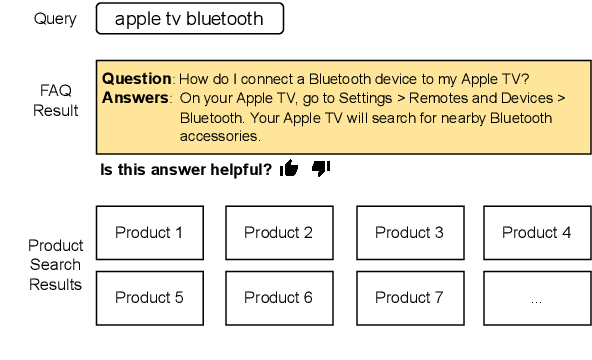
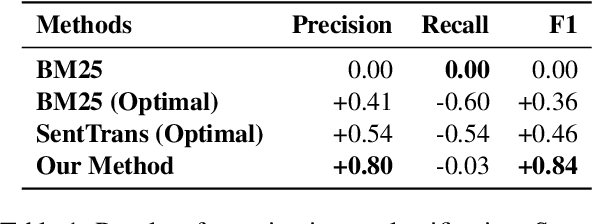

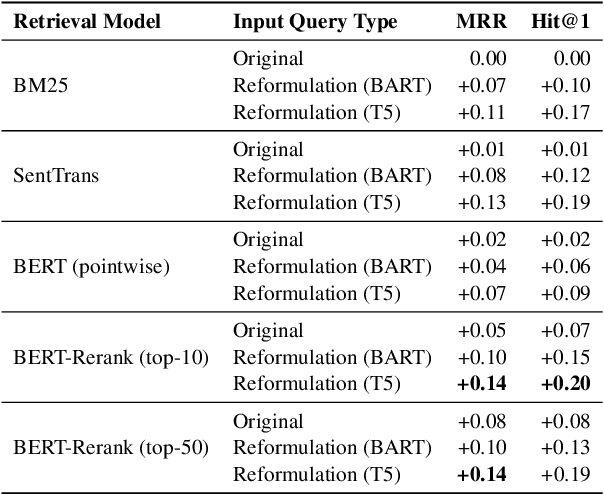
Abstract:Customers interacting with product search engines are increasingly formulating information-seeking queries. Frequently Asked Question (FAQ) retrieval aims to retrieve common question-answer pairs for a user query with question intent. Integrating FAQ retrieval in product search can not only empower users to make more informed purchase decisions, but also enhance user retention through efficient post-purchase support. Determining when an FAQ entry can satisfy a user's information need within product search, without disrupting their shopping experience, represents an important challenge. We propose an intent-aware FAQ retrieval system consisting of (1) an intent classifier that predicts when a user's information need can be answered by an FAQ; (2) a reformulation model that rewrites a query into a natural question. Offline evaluation demonstrates that our approach improves Hit@1 by 13% on retrieving ground-truth FAQs, while reducing latency by 95% compared to baseline systems. These improvements are further validated by real user feedback, where 71% of displayed FAQs on top of product search results received explicit positive user feedback. Overall, our findings show promising directions for integrating FAQ retrieval into product search at scale.
 Add to Chrome
Add to Chrome Add to Firefox
Add to Firefox Add to Edge
Add to Edge